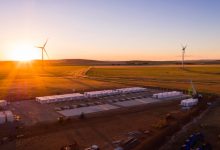South Australia’s plans to reach net 100 per cent renewables within a decade, and help provide renewable power to NSW to offset the closure of its coal plants have received a major boost after the Australian Energy Regulator green-lighted the business case for a major new transmission line linking the two states.
The AER on Friday approved as “robust” the regulatory investment test for transmission (RIT-T) for the $1.5 billion, 900km Project EnergyConnect transmission line proposed between Robertstown in S.A. and Wagga Wagga in NSW, a project being led by network companies ElectraNet and TransGrid.
The approval is being celebrated as an important milestone, and not just by the project’s proponents: The South Australian government on Friday described the interconnector as “the foundation piece” of its stunning net-100% renewable plans.
The new link is critical for the development of more than 5,000MW of wind, solar and storage plants in South Australia and in south west NSW, including huge projects such as Neoen’s massive Goyder project mixing wind, solar and storage, and the Susan River solar and battery storage project, which has already signed a contract with Alinta Energy.
South Australia is the main beneficiary. Its Liberal state government wants to reach “net 100 per cent” renewables by around 2030 (it will likely reach that milestone much earlier) and then become a net exporter to states such as NSW. At least half a dozen large renewables and storage projects have jockeyed for position in anticipation of the new transmission line.
“This project will unlock huge new renewable energy zones in South Australia and NSW with AEMO (the Australian Energy Market Operator)( reporting there are more than 5000MWs of planned renewable energy projects in close proximity to the interconnector,” South Australia energy minister Dan van Holst Pellekaan said in a statement.
“South Australia is determined to be a good global citizen, and become a net exporter of renewable energy as part of our aspiration of net-100% renewables in the 2030’s.
“The AER’s determination shows that South Australian wind and solar power can play a bigger national role with the interconnector, delivering more jobs and growth in South Australia.”
The link is an important part of AEMO’s Integrated System Plan, which plots a 20 year blueprint for the national grid to reach between 70 and 90 per cent renewables by 2041/42. The new line means that South Australia, already with more than 50 per cent wind and solar, will be part of a grid “loop”, rather than at the end of a skinny network.
“The SA/NSW Interconnector will also improve South Australia’s electricity systems resilience to external shocks,” van Holst Pellekaan said. “With climate change leading to increased extreme weather conditions such as storms, floods and fires, being interconnected with just Victoria leaves South Australia at real risk of becoming disconnected from the rest of the market.”
The ruling from the AER is also significant because it was delivered – as requested by AEMO and the South Australia state government – in record time as part of an overall fast-tracking of regulatory processes, which often occur at a glacial pace.
In a statement, the AER said the proposed inter-connector would facilitate the long-term transition of the energy sector to low emission energy sources and enhance power system security in South Australia.
“We’re satisfied, on the basis of the information ElectraNet has provided, that the SA-NSW interconnector is the best option for meeting the needs of consumers when compared to alternative options,” new AER chair Clare Savage said in a statement.
“We’ve tested the reasonableness of ElectraNet’s inputs and assumptions across a range of scenarios and found that the project, as set out in the RIT-T, is robust and will deliver a net economic benefit to Australian energy consumers.”
In a joint statement from ElectraNet and TransGrid, said the new link would enable the sharing of renewable and baseload generation in the National Energy Market.
These include the recently unveiled plans of Neoen Australia, to build a massive new renewables and battery project in South Australia’s mid north, with up to 1200MW of wind, 600MW of solar, and up to 900MW of battery storage (the number of hours of storage is yet to be determined).
Neoen – which already owns and operates the Hornsdale wind farm and the neighbouring Hornsdale Power Reserve (aka, the Tesla big battery), said the interconnector would open the door for new investment, and allow all energy users in other NEM states to benefit from South Australia’s world-class wind and solar resources.
“More specifically for us at Neoen, this decision provides a foundation for a project like Goyder… which will connect into the South Australian end-point for the new interconnector,” the company said.
Solar River, which proposes to build a 200MW solar farm with 100/MW/300MWh of battery storage, said the new interconnector “will be instrumental in unlocking further stages of energy generation and storage for the project.”
The Clean Energy Council was also keen to show its support of the AER’s determination on the new link, as a demonstration of the benefits that interconnection and renewables have for consumers.
“We strongly support the project, which passes through multiple renewable energy zones and will allow new renewable energy projects to connect to the National Electricity Market,” said the CEC’s director of energy transformation, Lillian Patterson, on Friday.
“Connecting more renewable energy projects will provide us with lower-cost and more diversified supply, which will increase reliability and ultimately result in lower energy prices for customers.
“This interconnector is important for the future of Australia’s National Electricity Market, as it builds a more flexible and resilient power system with more sources of clean energy.
“This interconnector will also generate new jobs and investment in regional areas, not just from the interconnector itself but also from new renewable energy projects.”










